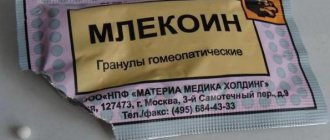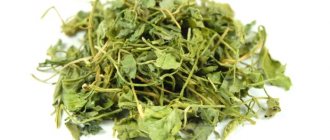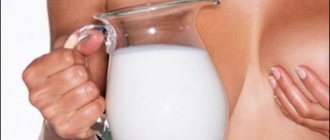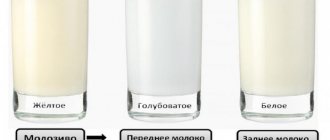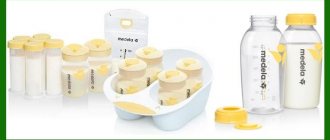When considering the composition of milk, it is worth considering that a homemade product and one that can be bought in a store are significantly different. The maximum concentration of nutrients is present in milk immediately after milking, but there are now few lovers of fresh milk, as well as people who can afford to purchase it. From this article you will learn what is included in milk and what its beneficial properties are.
Composition of milk: proteins, fats, carbohydrates
If we consider the composition of raw cow's milk in terms of its components, we can turn to the middle option - milk with a calorie content of 64 calories. This product contains 87.3 g of water, 3.2 g of protein, 3.6 g of fat, and 4.8 g of carbohydrates per 100 g. This is an excellent balanced product that will provide health benefits.
For comparison, the chemical composition of human milk contains an order of magnitude less protein: 1.5 g. At the same time, it contains 3.5 g of fat and 7.5 g of carbohydrates per 100 ml of product.
Vitamin and mineral composition of milk
Milk is rich in beneficial substances, which are found in it in a dissolved, easily digestible form. It includes: potassium, magnesium, calcium, sodium, iodine, cobalt, phosphorus, manganese, fluorine, zinc, molybdenum, copper and iron. These substances not only allow the body to maintain its functions, but also improve metabolic processes.
In addition, milk contains a number of vitamins - A, B-carotene, B1, B2, B9, C, PP and E. Thanks to the successful combination of vitamins and minerals, all substances in this combination are easily absorbed by the body, which allows milk to bring maximum benefits .
Composition and properties of milk
Due to its rich composition, milk can be used not only as food, but also for medicinal purposes. For example, milk promotes the following effects:
- thanks to the large amount of easily digestible calcium, milk strengthens teeth and bones;
- when drinking milk, the body easily resists various viral infections;
- a glass of warm milk at night is a sure cure for insomnia;
- If you drink a glass of milk with a raw egg every day for a week, you can get rid of migraines and headaches;
- milk perfectly lowers blood pressure;
- Drinking milk relieves heartburn symptoms;
- Thanks to vitamin B2, the body can cope with fat deposits more easily, which means milk is useful for losing weight.
In addition, milk is used in cosmetology, as it has a wonderful effect on the skin, making it light, moisturized and soft.
All about culinary art...
Many scientists agree that milk entered the human diet more than 7 thousand years ago. At the same time, people not only ate the raw product, but also made fermented milk products from it, including cheeses. Today, milk is one of the essential products and a fundamental drink in dietetics. Today we’ll talk about the composition, benefits and harms of milk.
Chemical composition of milk
If we express the chemical composition and BJU in numbers, then, taking into account the breed, feed, time of year, age of the animal, lactation period and processing technology, it looks like this:
Macroelements in a healthy product are represented by a wide range of substances, which together have a positive effect on the body. The following minerals are present in cow's milk (mg):
- calcium-120, of which 11% are free molecules that are ready to bind with other elements, 66% are phosphates and citrates, 23% are molecules bound to casein;
- phosphorus - about 75-130, its content depends on the breed of animal, diet, and time of year: the lowest content is in the spring;
- potassium - 140-170;
- magnesium - 14;
- sulfur - 29;
- sodium - 30-75;
- chlorine - 110;
- zinc - 0.4.
Chemical composition and consumer properties of milk
Category: Milk and dairy products
Milk is a product of the normal secretion of the cow's mammary gland. From a physicochemical point of view, milk is a complex polydisperse system in which the dispersion medium is water, and the dispersed phase is substances in a molecular, colloidal and emulsion state. Milk sugar and mineral salts form molecular and ionic solutions. Proteins are in a dissolved (albumin and globulin) and colloidal (casein) state, milk fat is in the form of an emulsion.
The composition of milk is not constant and depends on the breed and age of the cow, feeding and housing conditions, level of productivity and method of milking, lactation period and other factors. The lactation period in cows lasts 10-11 months, during which time cows produce high-quality milk.
Chemicalization of agriculture, treatment of diseases in cattle, environmental pollution from enterprises and transport have led to an increase in the content of foreign substances in milk.
Milk components are divided into true and extraneous, and true components into major and minor based on their content in milk (Fig. 5.1).

The main components such as milk fat, lactose, bream, lactoalbunin, lactoglobulin are compounds that are synthesized in the mammary gland and are found only in milk.
When producing, assessing the composition and quality of milk, it is customary to highlight the content of the fat phase and milk plasma (all other components except fat).
From a technological and economic point of view, milk can be divided into water and dry matter, which includes milk fat and nonfat milk solids (SMR) (Fig. 5.2).

The greatest fluctuations in the chemical composition of milk occur due to changes in water and fat; the content of lactose, minerals and proteins is constant. Therefore, the content of SOMO can be used to judge the naturalness of milk.
Milk proteins.
In recent years, a strong opinion has emerged that proteins are the most valuable component of milk. Milk proteins are high-molecular compounds consisting of amino acids linked to each other by a peptide bond characteristic of proteins.
Milk proteins are divided into two main groups - breech and whey proteins.
Casein
belongs to complex proteins and is found in milk in the form of micelles. These micelles are formed with the participation of calcium, phosphorus, etc. ions. Casein micelles have a round shape and their size depends on the content of calcium ions. As the calcium content in milk decreases, these molecules break down into simpler casein complexes.
According to modern concepts, as-, B-, x-caseins of cow's milk are considered.
as-casein - the main part of milk caseins (60%), consists of three fractions: asl as2 as3.
B-caseins are phosphoproteins that are more sensitive than az-casein to temperature when precipitated by calcium ions.
x-casein is the only carbohydrate-containing casein.
Casein in dry form is a white powder, tasteless and odorless. In milk, casein is found in a colloidal solution in the form of a soluble calcium salt. Under the influence of acids, acid salts and enzymes, casein coagulates (coagulates) and precipitates. These properties allow the isolation of total casein from milk. After casein is removed, whey proteins (0.6%) remain in the milk.
Major whey proteins -
albumin and globulin. Albumin is a simple protein and is highly soluble in water. Under the influence of rennet and acids, albumin does not coagulate, and when heated to 70 ° C, it precipitates.
The largest part in the albumin fraction is 3-lactoalbumin, and a-lactoalbumin is the most thermostable whey protein. Albumin contains the valuable essential amino acid tryptophan (up to 7%), which is not contained in any protein.
Globulin
present in milk in a dissolved state. It also belongs to simple proteins; it coagulates when heated in a slightly acidic environment to a temperature of 72 ° C. Albumin and globulin are blood plasma proteins. Globulin is a carrier of immune bodies. The amount of whey proteins increases in colostrum up to 15%.
Of the other proteins, the most important is fat globule protein, which is a complex protein. The shells of fat globules consist of compounds of phospholipids and proteins (lipoproteins) and represent a lecithin-protein complex.
Whey proteins are increasingly used as additives in the production of dairy and other products. From a nutritional physiological point of view, whey proteins are more complete than casein, as they contain more essential acids and sulfur. The degree of absorption of milk proteins is 96-98%.
Milk fat
in its pure form it is an ester of trihydric alcohol glycerol, saturated and unsaturated fatty acids. Milk fat consists of triglycerides of saturated and unsaturated acids, free fatty acids and unsaponifiable substances (vitamins, phosphatides).
Milk fat is found in milk in the form of fatty globules 0.5-10 microns in size, surrounded by a lecithin-protein shell. The fat globule shell has a complex structure and chemical composition, has surface activity and stabilizes the fat globule emulsion.
Milk fat is dominated by oleic and palmitic acids. Milk fat, unlike other fats, contains an increased (about 8%) amount of low molecular weight (volatile) fatty acids (butyric, caproic, caprylic, capric).
To characterize the fatty acid composition of milk fat, the most important chemical numbers are used: saponification, iodine, Reichert-Meisl, Polenske. Milk fat is capable of undergoing phase changes. It can be in a solidified (crystalline) and molten state, the pour point is 18-23 ° C, the melting point is 27-34 9 C. The density of milk fat at a temperature of 20 °C is 0.930-0.938 g/cm3.
Depending on the temperature conditions of the environment, milk fat glycerides can form crystalline forms that differ in the structure of the crystal lattice, the shape of the crystals, and the melting point.
Milk fat is poorly resistant to high temperatures, light rays, water vapor, air oxygen, alkali and acid solutions. Under the influence of these factors, it hydrolyzes, becomes salty, oxidizes and goes rancid.
In addition to neutral fats, milk contains fat-like substances: phosphatides (phospholipids) and sterols. The main phosphatides are lecithin and cephalin, and the sterols are cholesterol and ergosterol. The energy value of milk fat is 37.7 kJ, digestibility is 95%.
Milk sugar (lactose)
According to the modern nomenclature of carbohydrates, it belongs to the class of oligosaccharides (disaccharides). Of the total solids content, lactose accounts for about 40% and 26% of the calorie content of milk.
Lactose plays an important role in developmental physiology, as it is practically the only carbohydrate received by newborn mammals from food. Chemical formula of lactose This disaccharide is broken down by the enzyme lactase, is a source of energy and regulates calcium metabolism.
In the human stomach, the enzyme lactase is detected already in the third month of fetal development, and its content is sufficient throughout life if milk is constantly included in the diet.
Lactose exists in two isomeric forms, which have different physical properties. These are the a- and b-forms of lactose, each of which can be hydrated and anhydride (anhydrous).
The mutual transfer of lactose can occur according to the following scheme:
The mutual transition of the a- and b-forms of lactose depends on the temperature and concentration of the solution.
Lactose is less sweet than sucrose and less soluble in water. If we take the sweetness of sucrose as 100 units, then the sweetness of fructose will be 125 units, glucose - 72 units, lactose - 38 units. At a temperature of 20 °C, the solubility of lactose is 16.1%, at 50 °C - 30.4%, at 100 °C - 61.2%, while the solubility of sucrose at these temperatures is 67.1; 74.2 and 83%. Lactose is the main source of energy for lactic acid bacteria, which ferment it into glucose and galactose and further to lactic acid. Under the influence of milk yeast, the end products of lactose breakdown are mainly alcohol and carbon dioxide.
The peculiarity of lactose is its slow absorption (assimilation) by the walls of the stomach and intestines. Reaching the large intestine, it stimulates the activity of bacteria producing lactic acid, which suppresses the development of putrefactive microflora.
The a-form of lactose predominates in milk, which gives milk a sweetish taste, is easily absorbed by the body, but does not exhibit pronounced bifidogenic properties (it is not a regulator of microbiological processes).

In addition to lactose, milk contains small amounts of other sugars - these are primarily amino sugars, which are associated with proteins and act as stimulants for the growth of microorganisms.
The digestibility of milk sugar is 99%. The energy value of lactose is 15.7 kJ.
Minerals
(milk salts). The term minerals refers to metal ions, as well as inorganic and organic acids of milk. Milk contains 0.7-0.8% minerals. Most of them are middle and acid salts of phosphoric acid. Of the salts of organic acids, there are mainly salts of casein and citric acids.
Minerals are found in all tissues of the body, participate in the formation of bones, maintain osmotic pressure of the blood, and are an integral part of enzymes and hormones.
Milk salts and microelements, along with other main components, determine the high nutritional and biological value of milk. A lack or excess of salts leads to a disruption of the colloidal system of proteins, as a result of which they precipitate. This property of milk is used for protein coagulation in the production of fermented milk products and cheeses.
Depending on the concentration in milk, ions are divided into micro- and macroelements.
The content of macroelements in milk depends on the breed of cows and the stage of lactation; their average values are given in table. 5.1.
Along with macroelements, milk also contains microelements (mg/1000 cm3) in the form of ions. Microelements are vital substances. They are part of many enzymes, activate or inhibit their action, and can be catalysts for chemical transformations of substances that cause various defects. Therefore, the concentration of microelements should not exceed permissible values.
The human body has a high need for microelements such as Fe, Cu, Co, Zn, J. A growing child's body especially needs minerals such as calcium, phosphorus, iron, magnesium.
Vitamins.
Vitamins are low molecular weight organic compounds that are not synthesized in the human body. They enter the body with food, do not have energetic or plastic properties, and exhibit biological effects in small doses.
According to the International Chemical Nomenclature, vitamins are divided into water-soluble, fat-soluble and vitamin-like substances.
Milk contains all vital vitamins, some in insufficient quantities. The content of vitamins depends on the season of the year, the breed of animals, the quality of feed, the conditions of storage and processing of milk.
The average vitamin composition of milk is given in table. 5.2.

Fat-soluble vitamins are resistant to heat and begin to degrade at temperatures above 120 ° C (vitamin A), but are not resistant to air, ultraviolet rays, and acids. Vitamin A gives butter its yellow color. Vitamin E is a fat antioxidant and protects vitamin A from oxidative damage.
Water-soluble vitamins, with the exception of vitamins C and B12, are heat stable. They withstand heating less well in an alkaline environment. Vitamin PP is almost completely preserved after heat treatment and storage of milk. Vitamin C is most destroyed during pasteurization and storage.
Enzymes
catalyze many biochemical processes occurring in milk and during the production of dairy products. They are formed from the mammary gland of an animal (native enzymes) or secreted by microorganisms. Milk enzymes such as lactase, phosphatase, reductase, peroxidase, lipase, protease, and amylase play an important role.
Lactase (galactosidase) breaks down milk sugar into glucose and galactose and is secreted by microorganisms.
Phosphatase (phosphomonoesterase) is of animal (native) and microbiological origin. The presence of phosphatase determines the pasteurization of milk.
Reductase is formed due to the development of foreign microorganisms. The reductase test indicates the class of milk purity in terms of bacterial contamination.
Peroxidase is an enzyme of animal origin that is destroyed by short-term heating to 75-80 °C. The presence of the peroxidase enzyme in milk determines the effectiveness of milk pasteurization.
Lipase (glycerol ester hydrolase) can be of native and microbiological origin. Its presence in dairy products with a high fat content is undesirable, since it breaks down milk fat into glycerol and fatty acids, which leads to a rancid taste. Lipase is destroyed at temperatures of 80-85 °C.
Thus, milk enzymes play a positive or negative role, their activity depends on temperature, pH value, concentration of milk solids, the amount of the enzyme itself, etc.
Immune bodies {antibodies), hormones
have bactericidal properties. They are formed in the animal’s body and suppress the development of microorganisms for a short time. The time during which the bactericidal properties of milk appear is called the bactericidal phase. Its duration depends on the temperature of the milk and is 3 hours at 30 °C, and more than a day at 5 °C.
Dyes (pigments)
have a dual nature (animal and plant origin). Pigments of plant origin enter milk from feed (carotene, chlorophyll). The presence of the pigment riboflavin in milk gives yellow color to milk and greenish-yellow color to whey.
Gases
are contained in milk in small quantities (50-80 cm3 per 1000 cm3), including 50-70% carbon dioxide, 10% oxygen and 30% nitrogen. During heat treatment, some of the gases evaporate.
Water
- the main component of milk. The amount of water determines the physical state of the product, physicochemical and biochemical processes. The intensity of biochemical and microbiological processes, as well as the shelf life of dairy products, depends on the activity of water and its binding energy.
What is the nutritional value of milk?
Dairy carbohydrates are lactose sugar, it is not as sweet as its plant counterpart, but its nutritional value is no less.
- During the boiling process, milk sugars caramelize, after which the drink acquires a special aroma, pleasant taste and slightly brownish tint.
- When exposed to lactic acid bacteria, sugar turns into acid, and casein in this case coagulates. In this way, sour cream, kefir, yogurt, cottage cheese and other nutritious and healthy products are obtained.
- Contains potassium, phosphorus, sodium and sulfur in an easily digestible form, which is important for a child’s nutrition, because at this age milk is the basis of nutrition.
- Zinc, fluorine, manganese, iodine have high nutritional value for the human body.
What are the benefits of Milk 3.2% fat, pasteurized
- Vitamin B12
plays an important role in the metabolism and transformation of amino acids. Folate and vitamin B12 are interconnected vitamins that are involved in hematopoiesis. A lack of vitamin B12 leads to the development of partial or secondary folate deficiency, as well as anemia, leukopenia, and thrombocytopenia. - Calcium
is the main component of our bones, acts as a regulator of the nervous system, and is involved in muscle contraction. Calcium deficiency leads to demineralization of the spine, pelvic bones and lower extremities, increasing the risk of developing osteoporosis. - Phosphorus
takes part in many physiological processes, including energy metabolism, regulates acid-base balance, is part of phospholipids, nucleotides and nucleic acids, and is necessary for the mineralization of bones and teeth. Deficiency leads to anorexia, anemia, and rickets.
You can see a complete guide to the healthiest foods in the “My Healthy Diet” app.
- home
- Product composition
- Composition of dairy products
- Chemical composition “Milk 3.2% fat, pasteurized”
Tags:
Milk 3.2% fat, pasteurized, calorie content 60 kcal, chemical composition, nutritional value, vitamins, minerals, benefits Milk 3.2% fat, pasteurized, calories, nutrients, beneficial properties Milk 3.2% fat, pasteurized
Energy value, or calorie content
- this is the amount of energy released in the human body from food during the digestion process. The energy value of the product is measured in kilocalories (kcal) or kilojoules (kJ) per 100 grams. product. The kilocalorie used to measure the energy value of food is also called a food calorie, so when caloric content is reported in (kilo)calories, the prefix kilo is often omitted. You can see detailed energy value tables for Russian products here.
The nutritional value
— content of carbohydrates, fats and proteins in the product.
Nutritional value of food product
- a set of properties of a food product, in the presence of which the physiological needs of a person for the necessary substances and energy are satisfied.
Vitamins
, organic substances required in small quantities in the diet of both humans and most vertebrates. Vitamin synthesis is usually carried out by plants, not animals. A person's daily requirement for vitamins is only a few milligrams or micrograms. Unlike inorganic substances, vitamins are destroyed by strong heat. Many vitamins are unstable and are “lost” during cooking or food processing.
source
Enzymes in milk
The product contains a number of enzymes, including:
According to GOST, a quality product must be a homogeneous, liquid substance of a white or slightly yellowish tint, and have a pleasant smell and taste.
The energy value depends on the fat content of the drink. Calorie content varies from 52 to 64 kcal per 100 grams. The glycemic index of milk is 35, which corresponds to a low level, but dishes made from milk may have higher values, depending on what products are included during preparation.
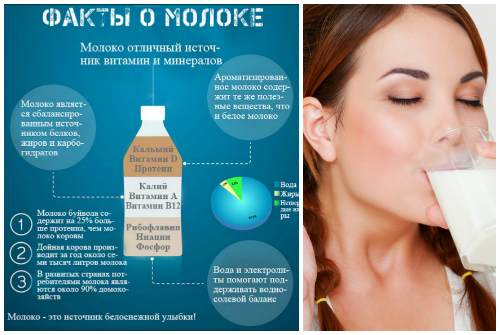
What are the benefits of Milk 2.5% fat, sterilized
- Calcium
is the main component of our bones, acts as a regulator of the nervous system, and is involved in muscle contraction. Calcium deficiency leads to demineralization of the spine, pelvic bones and lower extremities, increasing the risk of developing osteoporosis. - Phosphorus
takes part in many physiological processes, including energy metabolism, regulates acid-base balance, is part of phospholipids, nucleotides and nucleic acids, and is necessary for the mineralization of bones and teeth. Deficiency leads to anorexia, anemia, and rickets.
You can see a complete guide to the healthiest foods in the “My Healthy Diet” app.
- home
- Product composition
- Composition of dairy products
- Chemical composition “Milk 2.5% fat, sterilized”
Tags:
Milk 2.5% fat, sterilized, calorie content 54 kcal, chemical composition, nutritional value, vitamins, minerals, benefits Milk 2.5% fat, sterilized, calories, nutrients, beneficial properties Milk 2.5% fat, sterilized
Energy value, or calorie content
- this is the amount of energy released in the human body from food during the digestion process. The energy value of the product is measured in kilocalories (kcal) or kilojoules (kJ) per 100 grams. product. The kilocalorie used to measure the energy value of food is also called a food calorie, so when caloric content is reported in (kilo)calories, the prefix kilo is often omitted. You can see detailed energy value tables for Russian products here.
The nutritional value
— content of carbohydrates, fats and proteins in the product.
Nutritional value of food product
- a set of properties of a food product, in the presence of which the physiological needs of a person for the necessary substances and energy are satisfied.
Vitamins
, organic substances required in small quantities in the diet of both humans and most vertebrates. Vitamin synthesis is usually carried out by plants, not animals. A person's daily requirement for vitamins is only a few milligrams or micrograms. Unlike inorganic substances, vitamins are destroyed by strong heat. Many vitamins are unstable and are “lost” during cooking or food processing.
source
Types of fundamental product
Depending on the methods of production and storage, we can distinguish the following types of milk:
- Whole is a completely natural, raw substance that has not been subjected to even the slightest manipulation other than straining. Today, this species can only be purchased on agricultural farms or from rural residents.
Important! Buying milk by hand is risky, since each animal must undergo a medical examination twice a year and have the appropriate medical record.
- Pasteurized. This product was heated. Long pasteurization - 63-65 degrees for 30 minutes, short 85-90 degrees for a few seconds. In this case, the liquid warms up to 98 degrees. This process kills all microorganisms in the useful substance, which increases shelf life. The value of such a drink is several times lower compared to whole drink.
- Ultra-pasteurized - a product that is prepared by heating the substance to a temperature of 120-150 degrees for about 2-3 seconds. After warming up, the drink is distributed under sterile conditions into sealed bags. After such manipulation, the sealed pack is stored for more than a month.
Important! Ultra-pasteurization ensures that all beneficial substances and bacteria are killed.
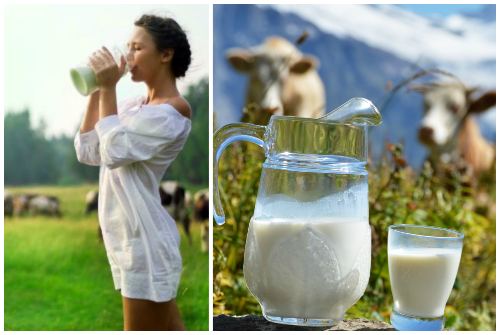
The benefits of milk for the body
The benefits and harms of cow's milk have been disputed for many years. The rich composition and vitamin complex may suffer from the conditions in which the cow is kept. In general, the benefits to human health include the following effects:
- A unique source of nutrients and vitamins that completely saturate the body.
- A large amount of calcium will have a positive effect on the beauty of your teeth and the strength of your bones. That is why those who like to drink a mug of steamed drink are much less likely to seek the services of a dentist. In addition, the risk of osteoporosis is reduced.
- Proteins grow and strengthen muscle mass, which is why the product is especially popular among athletes. Its popularity is not inferior to chicken eggs.
- Vitamins reduce stress levels. That is why drink a glass of warm milk at night after a hard day at work. Just one glass and the tension that has accumulated during the day will disappear. Women experience relief from premenstrual syndrome.
- The product helps to gently reduce blood pressure, reduces the risk of stroke and other heart diseases.
- Getting rid of heartburn, improving the digestive system, normalizing the feeling of hunger.
- For a long time, a bottle or pack of this drink has been given to workers in difficult industries in order to strengthen the immune system and restore vitality.
- The drink will relieve stress, help you cope with anemia and help you rehabilitate after tuberculosis.
Is there any harm from milk?
Recently, many scientists have been discussing more precisely the harm to the human body from milk.
- Allergic reactions are a common occurrence that can be found in 15% of residents. This manifests itself in the fact that after consumption a person experiences diarrhea and severe bloating. A protein allergy may have the same symptoms.
- It is difficult to call this product dietary in its original form, because whole milk is a source of fat. Nutritionists allow low-fat water, but in this case, opt for ordinary clean water.
Interesting! Allergies to milk depend on the nation. For example, in Europe, intolerance can actually be found in 2-5% of the population, and in Africa and Asia this figure grows to 50-75%.
Vegans and raw foodists talk about other harmful properties of this drink:
- increased stomach acidity;
- increases the risk of uterine cancer, but reduces the same intestinal disease, which is much more common;
- Casein is one of the strongest allergens, so all people prone to this disease should consult a doctor before consuming it.
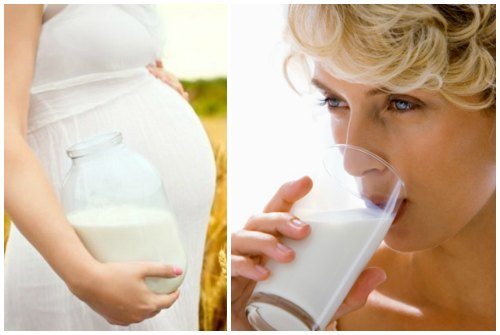
Milk has long been considered one of the fundamental products in the food system. Its benefits and harms depend on a number of conditions, such as the human factor, methods of processing raw materials, etc. You should approach the use of this drink based on the individual characteristics of the body.
Calorie content Milk 2.5% fat, sterilized. Chemical composition and nutritional value.
Nutritional value and chemical composition “Milk 2.5% fat, sterilized.”
| Nutrient | Quantity | Norm** | % of the norm in 100 g | % of the norm in 100 kcal | 100% normal |
| Calorie content | 54 kcal | 1684 kcal | 3.2% | 5.9% | 3119 g |
| Squirrels | 2.9 g | 76 g | 3.8% | 7% | 2621 g |
| Fats | 2.5 g | 56 g | 4.5% | 8.3% | 2240 g |
| Carbohydrates | 4.8 g | 219 g | 2.2% | 4.1% | 4563 g |
| Organic acids | 0.1 g | ||||
| Vitamin B1, thiamine | 0.02 mg | 1.5 mg | 1.3% | 2.4% | 7500 g |
| Vitamin B2, riboflavin | 0.13 mg | 1.8 mg | 7.2% | 13.3% | 1385 g |
| Vitamin B4, choline | 15.8 mg | 500 mg | 3.2% | 5.9% | 3165 g |
| Vitamin B5, pantothenic | 0.2 mg | 5 mg | 4% | 7.4% | 2500 g |
| Vitamin B6, pyridoxine | 0.025 mg | 2 mg | 1.3% | 2.4% | 8000 g |
| Vitamin B9, folates | 3 mcg | 400 mcg | 0.8% | 1.5% | 13333 g |
| Vitamin B12, cobalamin | 0.2 mcg | 3 mcg | 6.7% | 12.4% | 1500 g |
| Vitamin C, ascorbic acid | 0.6 mg | 90 mg | 0.7% | 1.3% | 15000 g |
| Vitamin D, calciferol | 0.03 mcg | 10 mcg | 0.3% | 0.6% | 33333 g |
| Vitamin H, biotin | 3.2 mcg | 50 mcg | 6.4% | 11.9% | 1563 g |
| Vitamin K, phylloquinone | 0.2 mcg | 120 mcg | 0.2% | 0.4% | 60000 g |
| Vitamin RR, NE | 0.8 mg | 20 mg | 4% | 7.4% | 2500 g |
| Niacin | 0.1 mg | ||||
| Macronutrients | |||||
| Potassium, K | 146 mg | 2500 mg | 5.8% | 10.7% | 1712 g |
| Calcium, Ca | 120 mg | 1000 mg | 12% | 22.2% | 833 g |
| Magnesium, Mg | 14 mg | 400 mg | 3.5% | 6.5% | 2857 g |
| Sodium, Na | 50 mg | 1300 mg | 3.8% | 7% | 2600 g |
| Sera, S | 29 mg | 1000 mg | 2.9% | 5.4% | 3448 g |
| Phosphorus, Ph | 90 mg | 800 mg | 11.3% | 20.9% | 889 g |
| Chlorine, Cl | 100 mg | 2300 mg | 4.3% | 8% | 2300 g |
| Microelements | |||||
| Aluminium, Al | 50 mcg | ||||
| Iron, Fe | 0.1 mg | 18 mg | 0.6% | 1.1% | 18000 g |
| Yod, I | 9 mcg | 150 mcg | 6% | 11.1% | 1667 g |
| Cobalt, Co | 0.9 mcg | 10 mcg | 9% | 16.7% | 1111 g |
| Manganese, Mn | 0.005 mg | 2 mg | 0.3% | 0.6% | 40000 g |
| Copper, Cu | 12 mcg | 1000 mcg | 1.2% | 2.2% | 8333 g |
| Molybdenum, Mo | 5 mcg | 70 mcg | 7.1% | 13.1% | 1400 g |
| Tin, Sn | 15 mcg | ||||
| Fluorine, F | 20 mcg | 4000 mcg | 0.5% | 0.9% | 20000 g |
| Chromium, Cr | 2 mcg | 50 mcg | 4% | 7.4% | 2500 g |
| Zinc, Zn | 0.4 mg | 12 mg | 3.3% | 6.1% | 3000 g |
| Digestible carbohydrates | |||||
| Mono- and disaccharides (sugars) | 4.8 g | max 100 g | |||
| Sterols (sterols) | |||||
| Cholesterol | 7 mg | max 300 mg | |||
| Saturated fatty acids | |||||
| Saturated fatty acids | 1.5 g | max 18.7 g | |||
| Monounsaturated fatty acids | 0.77 g | min 16.8 g | 4.6% | 8.5% | |
| Polyunsaturated fatty acids | 0.064 g | from 11.2 to 20.6 g | 0.6% | 1.1% | |
| Omega-3 fatty acids | 0.007 g | from 0.9 to 3.7 g | 0.8% | 1.5% | |
| Omega-6 fatty acids | 0.057 g | from 4.7 to 16.8 g | 1.2% | 2.2% |
Vitamins
Of the fat-soluble vitamins, cow's milk contains A, beta-carotene, E and K. Of the water-soluble vitamins, there are vitamins C, B1, B2, B3 (PP), B4, B5, B6, B9 and B12.
>’> >’> >’> >’> >’> >’> >’> >’> >’> >’> >’> >’> >’> >’> >’> >’> >’>
| Vitamins, content | Share of daily value per 100 g | |
| Vitamin A | 28.0 mcg | 3,1% |
| Beta carotene | 7.0 mcg | 0,1% |
| Alpha carotene | 0.0 µg | 0,0% |
| Vitamin D | 0.0 µg | 0,0% |
| Vitamin D2 | n/a | 0,0% |
| Vitamin D3 | 0.0 µg | 0,0% |
| Vitamin E | 0.0 mg | 0,2% |
| Vitamin K | 0.2 mcg | 0,2% |
| Vitamin C | 0.2 mg | 0,2% |
| Vitamin B1 | 0.0 mg | 3,3% |
| Vitamin B2 | 0.2 mg | 14,2% |
| Vitamin B3 | 0.1 mg | 0,6% |
| Vitamin B4 | 16.4 mg | 3,3% |
| Vitamin B5 | 0.4 mg | 7,1% |
| Vitamin B6 | 0.0 mg | 2,9% |
| Vitamin B9 | 5.0 mcg | 1,3% |
| Vitamin B12 | 0.5 mcg | 22,1% |
| Fat soluble Water soluble |
Calorie content Milk 3.2% fat, pasteurized. Chemical composition and nutritional value.
Nutritional value and chemical composition “Milk 3.2% fat, pasteurized.”
| Nutrient | Quantity | Norm** | % of the norm in 100 g | % of the norm in 100 kcal | 100% normal |
| Calorie content | 60 kcal | 1684 kcal | 3.6% | 6% | 2807 g |
| Squirrels | 2.9 g | 76 g | 3.8% | 6.3% | 2621 g |
| Fats | 3.2 g | 56 g | 5.7% | 9.5% | 1750 g |
| Carbohydrates | 4.7 g | 219 g | 2.1% | 3.5% | 4660 g |
| Organic acids | 0.1 g | ||||
| beta carotene | 0.01 mg | 5 mg | 0.2% | 0.3% | 50000 g |
| Vitamin B1, thiamine | 0.04 mg | 1.5 mg | 2.7% | 4.5% | 3750 g |
| Vitamin B2, riboflavin | 0.15 mg | 1.8 mg | 8.3% | 13.8% | 1200 g |
| Vitamin B4, choline | 23.6 mg | 500 mg | 4.7% | 7.8% | 2119 g |
| Vitamin B5, pantothenic | 0.38 mg | 5 mg | 7.6% | 12.7% | 1316 g |
| Vitamin B6, pyridoxine | 0.05 mg | 2 mg | 2.5% | 4.2% | 4000 g |
| Vitamin B9, folates | 5 mcg | 400 mcg | 1.3% | 2.2% | 8000 g |
| Vitamin B12, cobalamin | 0.4 mcg | 3 mcg | 13.3% | 22.2% | 750 g |
| Vitamin C, ascorbic acid | 1.3 mg | 90 mg | 1.4% | 2.3% | 6923 g |
| Vitamin D, calciferol | 0.05 mcg | 10 mcg | 0.5% | 0.8% | 20000 g |
| Vitamin H, biotin | 3.2 mcg | 50 mcg | 6.4% | 10.7% | 1563 g |
| Vitamin K, phylloquinone | 0.3 mcg | 120 mcg | 0.3% | 0.5% | 40000 g |
| Vitamin RR, NE | 0.8 mg | 20 mg | 4% | 6.7% | 2500 g |
| Niacin | 0.1 mg | ||||
| Macronutrients | |||||
| Potassium, K | 146 mg | 2500 mg | 5.8% | 9.7% | 1712 g |
| Calcium, Ca | 120 mg | 1000 mg | 12% | 20% | 833 g |
| Magnesium, Mg | 14 mg | 400 mg | 3.5% | 5.8% | 2857 g |
| Sodium, Na | 50 mg | 1300 mg | 3.8% | 6.3% | 2600 g |
| Sera, S | 29 mg | 1000 mg | 2.9% | 4.8% | 3448 g |
| Phosphorus, Ph | 90 mg | 800 mg | 11.3% | 18.8% | 889 g |
| Chlorine, Cl | 110 mg | 2300 mg | 4.8% | 8% | 2091 g |
| Microelements | |||||
| Aluminium, Al | 50 mcg | ||||
| Iron, Fe | 0.1 mg | 18 mg | 0.6% | 1% | 18000 g |
| Yod, I | 9 mcg | 150 mcg | 6% | 10% | 1667 g |
| Cobalt, Co | 0.8 mcg | 10 mcg | 8% | 13.3% | 1250 g |
| Manganese, Mn | 0.006 mg | 2 mg | 0.3% | 0.5% | 33333 g |
| Copper, Cu | 12 mcg | 1000 mcg | 1.2% | 2% | 8333 g |
| Molybdenum, Mo | 5 mcg | 70 mcg | 7.1% | 11.8% | 1400 g |
| Tin, Sn | 13 mcg | ||||
| Fluorine, F | 20 mcg | 4000 mcg | 0.5% | 0.8% | 20000 g |
| Chromium, Cr | 2 mcg | 50 mcg | 4% | 6.7% | 2500 g |
| Zinc, Zn | 0.4 mg | 12 mg | 3.3% | 5.5% | 3000 g |
| Digestible carbohydrates | |||||
| Mono- and disaccharides (sugars) | 4.7 g | max 100 g | |||
| Sterols (sterols) | |||||
| Cholesterol | 9 mg | max 300 mg | |||
| Saturated fatty acids | |||||
| Saturated fatty acids | 2 g | max 18.7 g | |||
| Monounsaturated fatty acids | 0.97 g | min 16.8 g | 5.8% | 9.7% | |
| Polyunsaturated fatty acids | 0.192 g | from 11.2 to 20.6 g | 1.7% | 2.8% | |
| Omega-3 fatty acids | 0.027 g | from 0.9 to 3.7 g | 3% | 5% | |
| Omega-6 fatty acids | 0.16 g | from 4.7 to 16.8 g | 3.4% | 5.7% |
Energy value Milk 3.2% fat, pasteurized is 60 kcal.
- Glass 250 ml = 250 g (150 kcal)
- Glass 200 ml = 200 g (120 kcal)
- Tablespoon (“with top” except for liquid products) = 18 g (10.8 kcal)
- A teaspoon (“with the top” except for liquid products) = 5 g (3 kcal)
Main source: Skurikhin I.M. and others. Chemical composition of food products. Read more.
** This table shows the average levels of vitamins and minerals for an adult. If you want to know the norms taking into account your gender, age and other factors, then use the “My Healthy Diet” application.
Mineral composition
The ratio of minerals (macro- and microelements) contained in cow's milk is presented in the table using diagrams.
>’> >’> >’> >’> >’> >’> >’> >’> >’> >’> >’>
| Minerals, content | Share of daily value per 100 g | |
| Calcium | 120.0 mg | 12,0% |
| Iron | 0.0 mg | 0,2% |
| Magnesium | 11.0 mg | 2,8% |
| Phosphorus | 92.0 mg | 13,1% |
| Potassium | 140.0 mg | 3,0% |
| Sodium | 47.0 mg | 3,6% |
| Zinc | 0.5 mg | 4,4% |
| Copper | 0.0 mg | 0,7% |
| Manganese | 0.0 mg | 0,6% |
| Selenium | 2.5 mcg | 4,5% |
| Fluorine | 3.4 mcg | 0,1% |
Compound

Milk has a complex composition, which depends on many factors: the physiological state of the animal, breed, diet, time of year. Milk from animals of the same species (for example, cows) can have different indicators in different animals.
Thus, the fat content in cow's milk can range from 3 to 6%, the protein content from 3 to 4%, and the lactose (milk sugar) content from 4.7 to 5.6%. One cow's milk may be sweet and another's milk may be watery.
In general, the composition of milk is quite complex. The product contains more than a hundred organic (proteins, fats, carbohydrates, enzymes, vitamins) and inorganic (water, mineral salts, gases) substances.
Milk proteins are the most valuable component of milk. They are more complete than meat and fish proteins and are digested faster. Protein is necessary for the formation of new cells in the human body. Milk proteins consist of three components: casein, albumin and globulin, which are dissolved in raw milk.
All milk proteins belong to the group of complete proteins, i.e. those that contain all 20 amino acids. These include 8 essential amino acids that cannot be synthesized in the human body and must be supplied with food. The absence of at least one of them entails metabolic disorders. Among the essential amino acids, three are especially important: methionine, lysine and tryptophan.
Lactose is milk sugar. It is a stimulant of the nervous system and a preventive agent for cardiovascular diseases.
Despite the use of lactose for medicinal purposes, many people do not digest lactose and cause disturbances in the digestive system. These people lack or produce insufficient quantities of the lactase enzyme. The purpose of lactase is to break down lactose into its parts, glucose and galactose, which must then be absorbed by the small intestine. With insufficient lactase function, lactose remains in the intestine in its original form, binds water and causes further digestive disorders.
As geneticists have found out, humanity did not immediately learn to benefit from such a unique product as milk. Milk tolerance appeared only with the spread of the lactose tolerance gene. It is known that this gene originated in Northern Europe around 5000 BC. e., where it currently has the highest frequency. Good tolerance to milk sugar gave carriers of this gene an advantage in the fight for survival and allowed it to spread widely.
Impaired lactase synthesis is the cause of congenital milk intolerance in newborns. In some adults, lactase activity may decrease, and then dairy products will also be difficult to digest. The reason for this is a disease of the digestive tract or prolonged abstinence from drinking milk. But these changes are not associated with age, but with the characteristics of the digestive system of an individual person.
Milk fat is a rich source of energy for the body. Fat is easily digested. It is found in milk in the form of tiny fat globules. Milk fat is the most complete: it contains all currently known fatty acids, including essential ones, which are not synthesized by the body and must be supplied with food. Milk fat is rich in vitamins A, D, E and K, which are almost absent in other animal fats.
Minerals - salts of calcium, potassium, sodium, magnesium, iron, citric, phosphoric, hydrochloric and other acids. They are found in milk in an easily digestible form. Milk contains trace elements in small quantities: cobalt, copper, zinc, manganese, fluorine, bromine, iodine, arsenic, silicon, boron, vanadium, etc. Microelements are necessary for the restoration of blood, lymph, gastric and intestinal juice, sweat, saliva, tears etc. Without their participation, the activity of such important endocrine glands as the thyroid, reproductive, etc. would be impossible.
Vitamins . Milk contains fat-soluble vitamins (A, D, E, K) and water-soluble vitamins (group B and ascorbic acid). Currently, over 30 vitamins are known to be found in milk. However, it is a significant source of only three of them: A, B1, B2.
Vitamin A – retinol. It is formed in the intestinal mucosa of animals from carotenes in food. The daily human need for vitamin A is 1 mg. Summer milk is richer in this vitamin compared to winter milk. Storing milk leads to a decrease in the content of vitamin A. This vitamin can withstand heat (up to 120°C) without access to air. Destroyed under the influence of oxygen and light.
Vitamin B1 – thiamine. The daily requirement for it is 2 mg. Destroys in an alkaline environment.
Vitamin B2 – riboflavin. The daily requirement is also 2 mg. Pasteurization of milk almost does not reduce the content of this vitamin.

